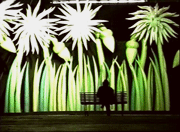Mike Hoolboom continues to refine the tonally complex, multi-chapter, mixed media compositions of his 2003 video essay, Imitations of Life with his latest – and equally ambitious and inspired – offering, Public Lighting. In the prologue, a restless young writer muses that, “every wound gives off its own light, and some of these wounds are words” and subsequently, takes on the idea of collecting these transitory thoughts of intimate and personal (albeit, non-autobiographical) experiences as light sources to create an illuminating collage of “personalities” – a public lighting – that, when taken together, invariably define the nature of human interaction.
The first installment is composed of primarily black and white shots of familiar streets, city sidewalks, and neighborhood haunts as a male voice recounts his memories of the moments of breakup with lovers and friends, and nostalgic, often embarrassing episodes of missed connection. Images of transience are presented in altered time – trains traversing railroad tracks, swimmers in a pool, automobiles alternately driving by in slow motion and Koyaanisqatsi hyperkinetics – drifting through a Wong Kar-wai-like warped space-time continuum that reveals the underlying atemporality of rejection, longing, and regret.
The second installment is an impressionistic portrait of composer Philip Glass, told through a repeated and complementary series of antique photographs and subterranean images – train stations and commuter tunnels – that visually reflect the harmonic repetition and reverberation innate in Glass’ compositions. Replacing dialogue and voice-over narration with subtitled commentary, Hoolboom differentiates between identification (as in the association of image to sound or idea to text) and identity (the repetitive tonality that makes a Glass composition immediately identifiable): a theme encapsulated in the observation, “It is not the melody people listen to but its persistence”.
The third installment is the most iconic and immediately (and notoriously) identifiable, Hey Madonna, a collage of images, film excerpts from the pop star’s documentary/exposé Truth or Dare, and the music video for Vogue – a life lived in seeming perpetuity (and perhaps intentionally) before the camera. But beyond the superficiality and narcissism in the eternal quest of the limelight, Hoolboom (superim)poses an existential question, “Is being photographed the only way to cheat death?” as the estranged interactions in the life of an HIV positive patient contacting former lovers, told through overlaid text, confront the audience (and consequently, expose the artifice) with more fundamental issues of mortality and legacy, as well the anonymous and humiliating, yet self-enlightening spectacle of terminal illness and the process of death.
The theme of interrelation between camera and personality carries through to the remaining installments of the film. In the fourth installment entitled Tradition, a woman of Chinese ancestry meticulously captures every family gathering on video, remarking that, “I take pictures, not to remember, but to record my forgetting”. Rather than perpetuating the cult of personality (as in the previous installment), the camera serves as a means of reinforcing identity, existence, and sense of place in a society where integration and assimilation of Western ideals are synonymous with cultural self-erasure.
The fifth installment represents the most somber, estranged, and austere portrait in its exposition of the camera as testament of human history. Told from the perspective of a silent, introspective photographer named Hiro who serves as an unobtrusive chronicler of night-time cityscapes juxtaposed against images of war-ravaged towns (including the ruins of post-atomic bombing Hiroshima), Hoolboom similarly evokes the theme of a culturally endemic collective amnesia (in the inclusion of a fluff commercial spot) explored by Chris Marker’s Level Five and in the haunted memory of the present that pervades Alain Resnais’ early feature films. Devoid of dialogue, subtitles, overlaid texts – in essence, all words – the sequence becomes a reflection of humanity as an eternal, impotent, mute witness to barbarism and man-made tragedy.
In some ways, the final installment, Amy, serves as both an antithesis and a corollary to the limelight-seeking exhibitionism of the third chapter, as a young woman reveals her feelings of violation after being photographed in the nude by a fashion photographer during her adolescence. Presented as a series of formally modeled photographs and told in voice-over commentary by an actress in a recording studio, Hoolboom underscores the theme of objectification as the young woman’s memories of self-consciousness at being intimately photographed by a virtual stranger is further reinforced by substituting the voice of the model – in essence, silencing her articulation of her own thoughts – in order to create an aesthetic ideal for the video camera. In this instance, the loss of innocence comes, not from a physical violation, but from the conditionally learned consciousness of being filmed and the realization of performance.
© Acquarello 2005. All rights reserved.
